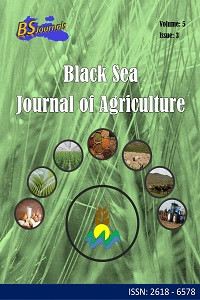Abstract
This study was carried out to determine the structural characteristics of sheep breeding, herd owners, and general characteristics of sheep breeding enterprises in Ordu province by survey method. There are 1883 sheep farms in Ordu, and it has been determined that in 1116 (59.27%) of these farms, the number of sheep is below 100 heads, the number of animals per farm, in general, varies between 1-3242 heads, and the average number of animals per farm is 102 heads. The study data were obtained from 76 farms selected according to the stratified sampling method among 100 animals or more farms. Of the 76 breeders surveyed, 59.21% graduated from primary school, 14.47% from secondary school, 22.36% from high school and 3.95 bachelor degrees. It has been determined that the level of education does not make a difference in production, management, and the attempt to do additional work (2=9.666, P=0.139). In the study, 26.3% of the herd owners are engaged in sheep breeding as a source of livelihood, while the remaining 73.7% are involved in sheep breeding together with other business areas. In conclusion, it was determined that the level of education, experience, age, and additional work status of the breeders were not effective on the size of the flock, the number of lambs obtained per ewe, lamb survivability and business management in sheep farms. As a result, for sheep farms to reach a more profitable, innovative and sustainable situation in Ordu province, those with less than 100 sheep per farm should be encouraged to increase the number of animals and the problem of finding a shepherd should be resolved.
Keywords
References
- Anonim. 2022. Hayvancılık bilgi sistemi. T.C. Tarım ve Orman Bakanlığı, URL: https://hbs.tarbil.gov.tr/ (access date: May 16, 2022).
- Düzgüneş O, Eliçin A, Akman. 2012. Hayvan ıslahi. Ankara Üniversitesi Ziraat Fakültesi, Yayın No:1599, Ders Kitabı No: 551, Ankara, ss. 1-30.
- Işık A. 2006. Uygulamalı istatistik-I. Beta Basım Yayım Dağıtım AŞ., Himaye-i Eftal Sok. Talas Han No: 13-15, Cağaloğlu, İstanbul, Türkiye, pp. 510.
- Marcone G, Carnovale F, Arney D, De Rosa G, Napolitano F. 2022. A simple method for on-farm evaluation of sheep welfare using animal-based indicators. Small Rum Res, 208: 106636.
- Mujica PT, Riveros JL. 2021. Sheep production systems in Chilean Patagonia. Characterization and typology. Small Rum Res, 204: 106516.
- Olaizola AM, Ameen F, Manrique E. 2015. Potential strategies of adaptation of mixed sheep-crop systems to changes in the economic environment in a Mediterranean mountain area. Livest Sci, 176: 166–180.
- Park S. Deller S. 2021. Effect of farm structure on rural community well-being. J Rural Stud, 87: 300-313.
- Unay-Gailhard I, Bojnec Š. 2021. Gender and the environmental concerns of young farmers: Do young women farmers make a difference on family farms? J Rural Stud, 88: 71-82.
Abstract
Supporting Institution
ondokuz mayıs üniversitesi ziraat fakültesi
Thanks
Yazarlar herhangi bir kurum veya kişiden herhangi bir maddi destek almadıklarını beyan ederler.
References
- Anonim. 2022. Hayvancılık bilgi sistemi. T.C. Tarım ve Orman Bakanlığı, URL: https://hbs.tarbil.gov.tr/ (access date: May 16, 2022).
- Düzgüneş O, Eliçin A, Akman. 2012. Hayvan ıslahi. Ankara Üniversitesi Ziraat Fakültesi, Yayın No:1599, Ders Kitabı No: 551, Ankara, ss. 1-30.
- Işık A. 2006. Uygulamalı istatistik-I. Beta Basım Yayım Dağıtım AŞ., Himaye-i Eftal Sok. Talas Han No: 13-15, Cağaloğlu, İstanbul, Türkiye, pp. 510.
- Marcone G, Carnovale F, Arney D, De Rosa G, Napolitano F. 2022. A simple method for on-farm evaluation of sheep welfare using animal-based indicators. Small Rum Res, 208: 106636.
- Mujica PT, Riveros JL. 2021. Sheep production systems in Chilean Patagonia. Characterization and typology. Small Rum Res, 204: 106516.
- Olaizola AM, Ameen F, Manrique E. 2015. Potential strategies of adaptation of mixed sheep-crop systems to changes in the economic environment in a Mediterranean mountain area. Livest Sci, 176: 166–180.
- Park S. Deller S. 2021. Effect of farm structure on rural community well-being. J Rural Stud, 87: 300-313.
- Unay-Gailhard I, Bojnec Š. 2021. Gender and the environmental concerns of young farmers: Do young women farmers make a difference on family farms? J Rural Stud, 88: 71-82.
Details
| Primary Language | English |
|---|---|
| Subjects | Zootechny (Other) |
| Journal Section | Research Articles |
| Authors | |
| Publication Date | July 1, 2022 |
| Submission Date | May 5, 2022 |
| Acceptance Date | June 20, 2022 |
| Published in Issue | Year 2022 Volume: 5 Issue: 3 |


